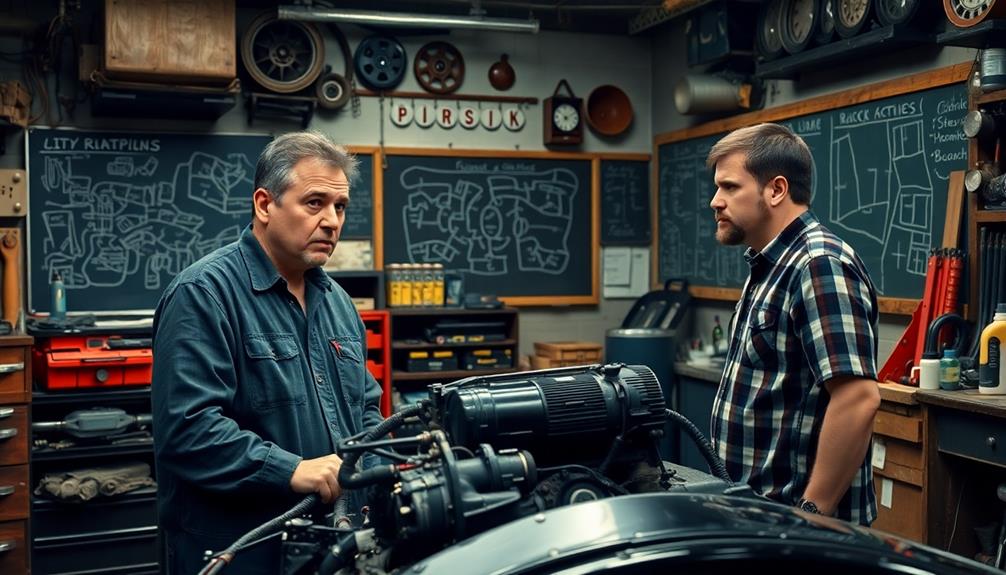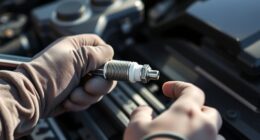To create a thriving automotive repair shop, focus on layout, tools, customer experience, staff training, and marketing. Start by optimizing your space with a linear design, ensuring each lift has enough clearance. Invest in quality tools and keep them well-maintained to boost productivity. Enhance the customer experience with a clean waiting area and clear signage. Train your staff continuously on new technologies while emphasizing strong customer service skills. Finally, employ innovative marketing strategies, like seasonal campaigns and social media engagement, to attract new clients. There's so much more to explore to set your shop apart and succeed. Additionally, consider building a strong online presence by incorporating modern **automotive marketing strategies** such as search engine optimization (SEO) and targeted ads to reach your local audience more effectively. Partnering with other local businesses for cross-promotions can also amplify your shop’s visibility and attract a loyal customer base.
Key Takeaways
- Design an efficient workshop layout with clearly designated zones for service bays, parts storage, and customer waiting areas to enhance workflow.
- Invest in quality tools and equipment, including diagnostic machines, to ensure reliable repairs and minimize service time.
- Create a clean, organized waiting room with comfortable seating and clear signage to improve customer experience and satisfaction.
- Implement ongoing staff training programs to keep technicians updated on new technologies and enhance their customer service skills.
- Utilize innovative marketing strategies, such as seasonal campaigns and referral programs, to attract and retain customers effectively.
Optimizing Your Shop Layout
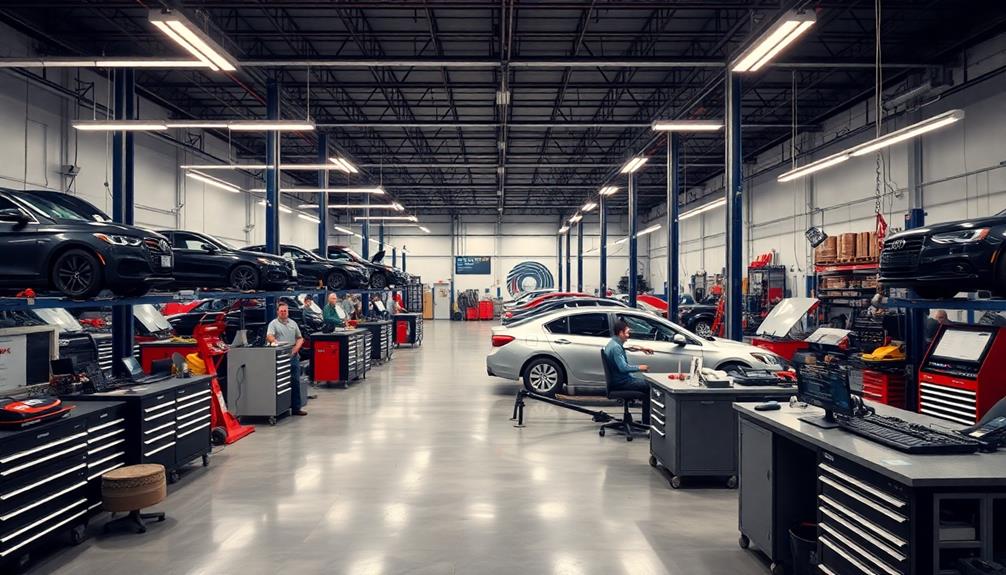
Creating an efficient workshop layout is vital for maximizing productivity and enhancing customer satisfaction. In your auto repair shop, aim for an ideal layout of approximately 23 x 60 feet. This size accommodates multiple vehicle workspaces while ensuring smooth movement and accessibility.
Utilize a linear layout for service bays to facilitate easy access, minimizing the time spent shifting vehicles and reducing collision risks. Each two-post lift requires about 15 feet of horizontal space, so plan for a recommended 4 feet of clearance next to the lift. This clearance is essential for toolbox mobility and emergency access.
Designate specific zones for parts storage, equipment organization, and customer waiting areas. This organization improves overall workflow and elevates the customer experience.
Don't forget to take into account modular designs for flexibility. A reconfigurable layout allows you to adapt to changing service demands, optimizing technician productivity.
As a service advisor, you'll appreciate how a well-structured shop layout can streamline processes and enhance communication with customers. By investing time in optimizing your shop layout, you'll create an efficient environment that benefits both your team and your clients.
Essential Tools and Equipment
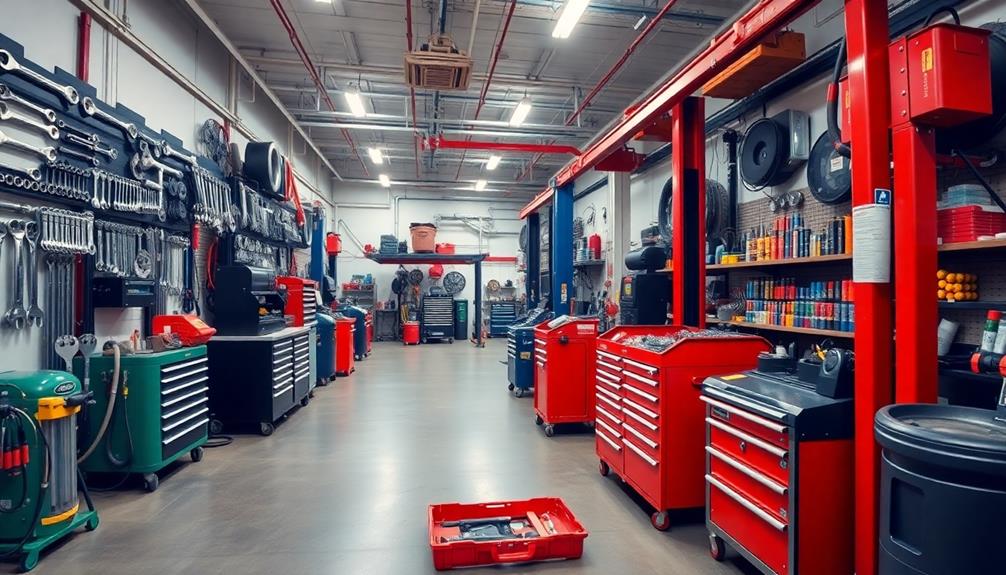
In an automotive repair shop, having the right tools and equipment is essential for getting the job done efficiently. This includes lifts, wrenches, and specialized equipment tailored to various repair tasks. By ensuring you have quality tools, your technicians can perform a wide range of services with ease.
Regular maintenance of these tools is critical; well-maintained tools can greatly reduce service time and boost overall productivity. Safety gear, such as gloves and goggles, is mandatory for all personnel to prevent injuries while using heavy machinery and handling hazardous materials.
An efficient inventory management system plays an important role in tracking tool usage and availability, preventing downtime due to misplaced or broken tools. Investing in diagnostic machines allows for accurate troubleshooting of vehicle issues, enabling technicians to quickly identify problems.
Here's a quick overview of essential tools for your shop:
| Tool/Equipment | Purpose |
|---|---|
| Lifts | Elevate vehicles for easy access |
| Wrenches | Tighten and loosen bolts |
| Diagnostic Machines | Troubleshoot vehicle issues |
| Safety Gear | Protect personnel during repairs |
| Inventory Management | Track tool usage and availability |
Enhancing Customer Experience

A customer-focused automotive repair shop can greatly boost satisfaction and loyalty through thoughtful enhancements to the overall experience. Start by ensuring your waiting room is clean and organized, as 64% of customers typically wait for repairs. This environment not only enhances their perception but also opens up potential sales opportunities.
Additionally, implementing secure payment processing practices can reassure customers about the safety of their transactions, which is increasingly important in today's digital age (secure payment practices).
Clear signage throughout your shop is essential. It helps customers navigate easily, making their visit more enjoyable. Consider adding protective glass panels in smaller shops to maintain visibility between the waiting areas and service bays while minimizing noise disruption.
Offering educational materials and take-home resources can empower your customers with knowledge about their vehicles. This positions your shop as a trusted authority in automotive care, increasing their confidence in your services.
Lastly, implementing feedback mechanisms, like surveys, will allow you to gather valuable insights from your customers. Use this information to continuously improve your service quality, fostering long-term loyalty.
Staff Training and Development
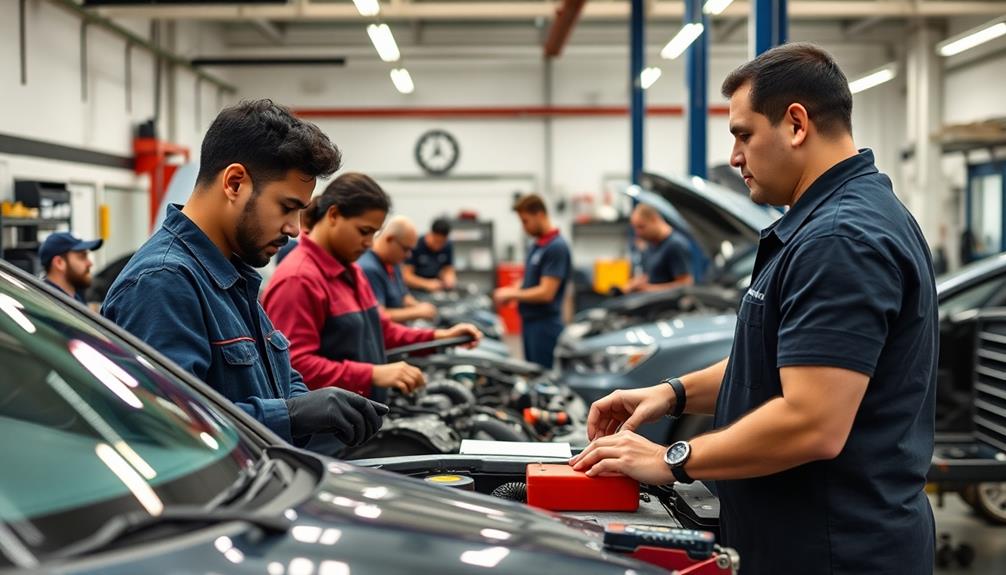
Enhancing customer experience doesn't stop at the waiting room; it extends to the skills and knowledge of your staff. Investing in ongoing training programs for your automotive technicians is essential. It keeps them updated on new technologies and repair techniques, ensuring efficient service delivery and customer satisfaction.
Additionally, incorporating techniques for stress management can further enhance your team's focus and performance under pressure. Certification programs for specialized automotive skills not only boost your team's expertise but also instill confidence in your customers regarding the quality of service.
Don't overlook the importance of staff training that emphasizes customer service and communication skills. By fostering these skills, you'll build better relationships with clients, leading to increased loyalty and repeat business.
Safety training is also vital for all personnel, promoting a secure working environment and reducing the likelihood of accidents in your shop.
Regular assessments and workshops can help you identify skill gaps among your staff, allowing for targeted training initiatives that enhance overall shop performance. By prioritizing staff training and development, you're not just improving individual capabilities; you're also elevating the entire customer experience, making your shop a trusted choice for automotive repair.
Innovative Marketing Strategies

To stand out in the competitive automotive repair industry, innovative marketing strategies are essential for attracting and retaining customers.
Implementing seasonal marketing campaigns can greatly boost customer engagement. Tailored promotions during peak times, like summer and winter, lead to higher service utilization.
Use a multi-channel approach for your auto repair marketing, combining social media, email newsletters, and direct mail to reach diverse demographics and draw in new customers.
Establish referral programs that offer clear incentives for satisfied customers to recommend your services. This word-of-mouth strategy can enhance customer acquisition and foster loyalty.
Additionally, engage your audience through video marketing by creating tutorials on car maintenance or showcasing completed projects. This not only enhances your brand authority but also captures attention on social media, driving traffic to your shop.
Frequently Asked Questions
How Do You Attract Customers to Auto Repair?
To attract customers, you should implement referral programs, optimize your online presence, and run seasonal promotions. Encourage positive reviews and host community events to build relationships and enhance your shop's visibility and credibility.
How to Make More Money in an Auto Repair Shop?
Think of your shop as a garden; nurturing it with proactive follow-ups, bundled services, and referral incentives will yield fruitful returns. Leverage CRM systems and seasonal campaigns to attract customers and boost your revenue considerably.
How Do I Cool My Auto Repair Shop?
To cool your shop, install high-efficiency ceiling fans and portable AC units. Insulate walls, maintain your HVAC system, and consider reflective roofing to lower temperatures effectively, ensuring a comfortable environment for you and your team.
What Is the Hardest Thing to Repair in a Car?
The hardest thing to repair in a car is often the engine. You'll face challenges with internal components, requiring extensive disassembly and specialized tools, which can be intimidating for even experienced mechanics.
Conclusion
In the fast-paced world of automotive repair, keeping your shop running like a well-oiled machine is key. By optimizing your layout, investing in essential tools, and focusing on customer experience, you'll create a welcoming environment that drives success. Don't forget to empower your staff through training and explore innovative marketing strategies to stand out in the crowd. With these strategies in place, you'll not only hit the ground running but also keep your business thriving for years to come.




